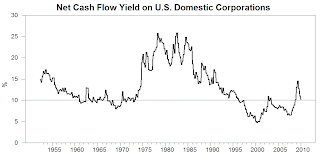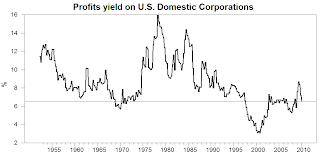A most important problem when trying to assess equity valuation, is that earnings often go all over the place, notably around recessions. Dividends are much more stable in the short run but they are subject to dividend distribution policy. Cash flows are not, and they are more stable than earnings as can be seen on the following chart (data from the BEA):
So let's chart what I would call the "cash flow yield" on U.S. equities, using this previous series (U.S. corporate net cash flows) and the market value of domestic corporations given by the Fed in its Z1 report:
The period average stands at about 13%, compared with today's 10%. So equities are 30% more expensive than during the past half century average using this measure. But note: if we excluded the bubble years of the past decade, the average would have been more in the area of 15%-16%. So stocks would be 50% overvalued at today's levels.
Using the more volatile (thus less reliable) corporate profits series, the picture is even bleaker: equities are more expensive than at any time in the past 50 years except for the bubble and a brief period in the late 1960's.
The last point I want to make concerning this subject is that, even at the bottom of the bear market earlier this year, stocks were never trading at "dirt cheap" levels such as those seen in the late 70's and early 80's.
That being said, markets can remain overvalued for extended periods of time. The only sure thing about today's valuation levels is that a buy-and-hold investor will not see a great performance of his portfolio in the long run. It does also increase the probabilities of a sell-off, as well as the extent of any sell-off should it occur. But since market breadth and internals have recently been very good, I believe the odds are for even higher prices in the short term. My opinion could change rapidly though.
Note: I will update my 2010 GDP forecast in the next few days.






Interesting stuff Mr Kahan
ReplyDeleteHow do you account for impact of inventory change (really working capital, but receivables/payables may cancel out quite a bit in aggregate) on the aggregate cash flow? Is your cash flow "operating cash flow"? If yes,I assume capex is not deducted in your "net cash flow" number, but if it has been then that is another factor that could swing wildly? Unless we can understand these affect your aggregate number (I can understand it on an individual business basis) I don't know why your cash flow number is any better than the "more volatile" earnings number.
ReplyDelete--HZ--
All legitimate questions HZ, and I'm afraid this measure of cash flow (which is not "mine" by the way, it is reported by the BEA in its GDP report) is not a 100% kosher free cash flow as should be theoretically used in equity valuation.
ReplyDeleteThe figure does account for inventory valuation adjustment and consumption of fixed capital though: see p. 15 of this pdf.
In any way, I was not trying to assign a precise "fair value" to U.S. equities, but more to point out, using the cash flow yield as an indicator, that they seemed very expensive. The conclusion is the same using profits, but this series (YoY) has a std dev of 13.58, while Corporate Net Cash Flow (YoY) has a std dev of 8.71.
Raphaël,
ReplyDeleteThanks for the idea and the response. I guess I had to look through the BEA manual to see the precise definition of the numbers. Thought provoking nonetheless.
Individual businesses have more volatile cash flows than earnings (think of retailers stocking up for Xmas, or farmers planting) but in aggregate they seem to behave differently. Interesting indeed.
As far as valuation goes, interest rate is a big factor that is not taken into account here, obviously. Last time we have this kind of low rate was probably in the 60s and today's market seems to be right at the 60s' level in terms of "cash flow yield". Averaging in 70/80's high inflation high interest rate yield seems a bit unfair?
HZ
Well remember your basic discounted cash flow formula: the cash flow at year n is discounted by the rate prevailing at year n, at year n+1 it is discounted by the rate for year n+1, etc. until infinity. Today's interest rates do not matter so much unless you believe they are going to stay that low in infinity. But then you would have to adjust your growth rates assumptions downwards as well.
ReplyDeleteSo in the end, I don't care so much for the so-called Fed model. Remember the 1930's to mid 1950's: even lower interest rates, far better equity valuations than today.
Raphaël,
ReplyDeleteFinally I was able to track down some BEA slides explaining the concepts:
http://www.bea.gov/papers/pdf/nabeprofits_fv.pdf
Check out page 12. It turns out that "cash flow" as defined by the BEA relates to the profits through subtracting dividends distributed, and adding back depreciation. While it is interesting to BEA since it is a measure of internally generated funds available for investments, it is certainly not as relevant as profits from the owners' perspective and therefore should has less meaning in relation to valuation. (Clearly more dividends do not make corporates less valuable, nor do more depreciation make corporations more valuable.)
Therefore while it appears that corporations managed their internally generated funds (say cutting dividends when earnings are poor) better than earnings, the less volatility does not appear to give the BEA version of "cash flow" more relevance to valuation.
It was an interesting journey into BEA stats nevertheless.
Happy 2010!
HZ
Thanks for this. Adding back depreciation does fit the equity valuation-based definition of free cash flows, excluding dividends does not indeed.
ReplyDeleteHowever, remember that we're not trying to do classical equity valuation here (and we couldn't, with regards to availability of data). The point was simply to provide an indicator of current valuations. For that purpose, excluding dividends does have the advantage of providing a less volatile series. Also, dividends are at management discretion: they can be cut very fast (and usually are) during recessions, even if the underlying earnings trend is not quite as bad.
Good discussion though! And happy new year
This comment has been removed by a blog administrator.
ReplyDeleteThis comment has been removed by a blog administrator.
ReplyDelete